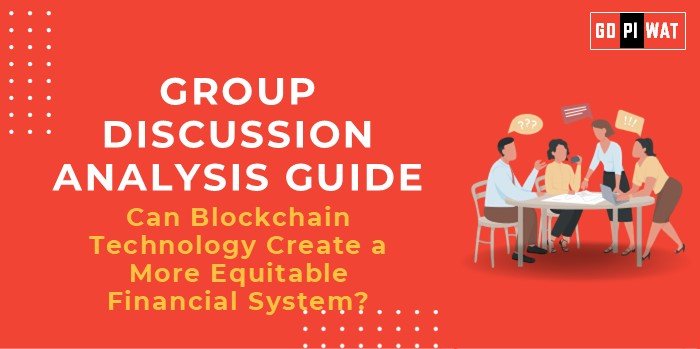📋 Group Discussion Analysis Guide
🌐 Topic: Can Blockchain Technology Create a More Equitable Financial System?
🌍 Introduction to Blockchain Technology in Finance
Opening Context: Blockchain technology is revolutionizing traditional finance by decentralizing transactions, improving transparency, and enhancing security. Its adoption could address systemic issues like financial exclusion and high transaction costs.
Topic Background: Emerging in 2008 as the foundation for Bitcoin, blockchain’s use has expanded beyond cryptocurrency to applications in banking, supply chain, and governance. Its potential for financial inclusivity is a focal point for B-school discussions.
📊 Quick Facts and Key Statistics
- Global Blockchain Market: Valued at $7.18 billion in 2022, projected to grow at a CAGR of 66.2% by 2030 (Fortune Business Insights).
- Unbanked Population: Over 1.4 billion adults lack access to banking services, with blockchain-powered mobile solutions offering potential pathways (World Bank, 2023).
- Remittance Costs: Average global remittance fees are 6.3%, but blockchain systems can reduce this to under 1% (World Bank, 2023).
- Smart Contracts: Ethereum processes 1.5 million daily transactions via smart contracts, streamlining decentralized finance.
👥 Stakeholders and Their Roles
- Governments: Regulating blockchain to ensure transparency and prevent misuse.
- Financial Institutions: Innovating with blockchain for faster, cost-efficient transactions.
- Technology Companies: Developing scalable blockchain solutions.
- Global Organizations: Promoting blockchain to bridge the financial inclusion gap (e.g., UN initiatives).
- Consumers: Benefiting from reduced costs and equitable access.
🏆 Achievements and Challenges
Achievements:
- Financial Inclusion: Blockchain-based wallets reach unbanked populations in remote areas.
- Reduced Costs: Significant savings in cross-border payments.
- Transparency: Immutable records reduce fraud and corruption.
- Global Examples: Kenya’s blockchain-powered mobile wallet (BitPesa) supports financial inclusion.
Challenges:
- Regulatory Uncertainty: Ambiguity in blockchain governance across countries.
- Scalability: Blockchain’s transaction capacity is limited compared to traditional systems.
- Environmental Impact: Energy-intensive proof-of-work protocols.
- Global Comparisons: While Estonia successfully integrates blockchain in governance, India’s progress is nascent.
📑 Structured Arguments for Discussion
- Supporting Stance: “Blockchain reduces remittance costs to under 1%, a significant boon for low-income families reliant on international transfers.”
- Opposing Stance: “Blockchain’s scalability issues make it impractical for widespread financial systems.”
- Balanced Perspective: “Blockchain holds promise but needs technological advancements and regulatory frameworks for equitable impact.”
💡 Effective Discussion Approaches
-
Opening Approaches:
- Statistical Highlight: “With blockchain remittance fees dropping below 1%, imagine the impact on global financial equality.”
- Contrast: “Despite blockchain’s promise, over 1 billion adults remain unbanked due to accessibility issues.”
-
Counter-Argument Handling:
- Highlight alternatives like improved fintech systems.
- Acknowledge blockchain’s limitations but present examples like Kenya’s BitPesa for impact.
📈 Strategic Analysis of Strengths and Weaknesses
- Strengths: Transparency, cost efficiency, inclusivity.
- Weaknesses: High energy consumption, scalability challenges.
- Opportunities: Integration with AI, expansion to underserved markets.
- Threats: Regulatory barriers, technology misuse.
🎓 Connecting with B-School Applications
- Real-World Applications:
- Finance: Blockchain’s role in reducing operational costs.
- Development: Social impact projects on financial inclusion.
- Sample Interview Questions:
- “How does blockchain support financial inclusion?”
- “Can blockchain replace traditional banking systems?”
- Insights for Students:
- Explore blockchain’s scalability solutions like proof-of-stake.
- Analyze blockchain’s role in risk management and compliance.


